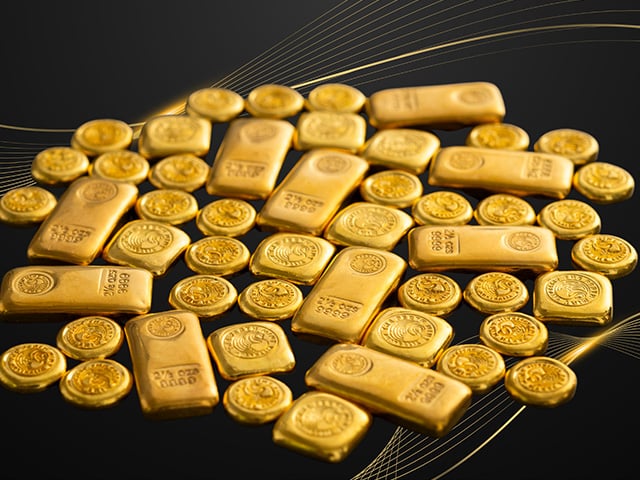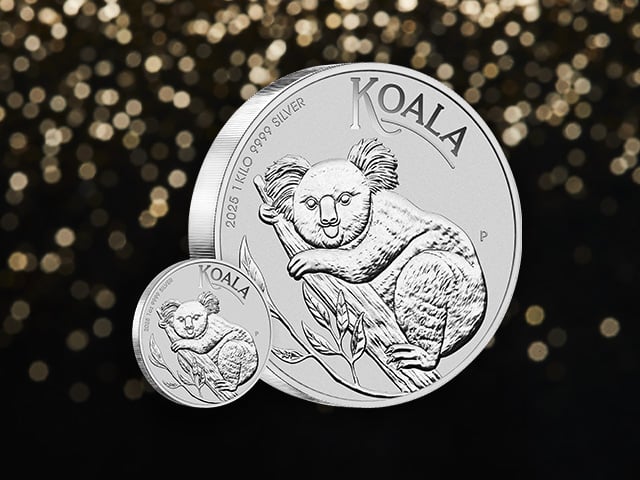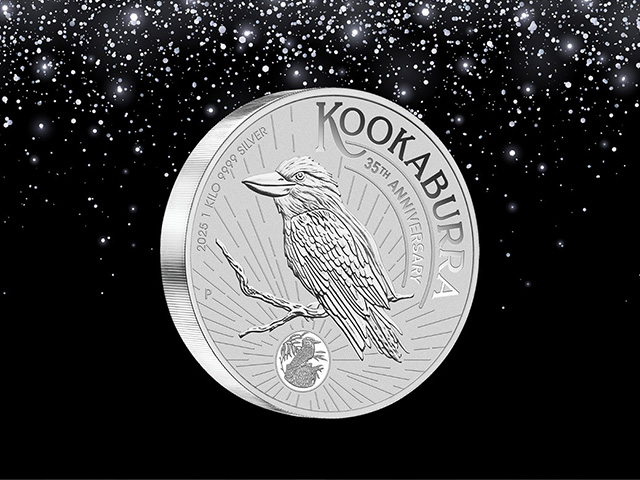Monetary stimulus fuels gold rally

- The price of both gold and silver rose by over 8% in April, with gold ending the month above USD 1,700 per troy ounce.
- In AUD terms, gold and silver rose by just over 1.50%, with the AUD rallying more than 6% in April, ending the month above USD 0.65.
- Demand for Perth Mint products was strong, with continued inflows into ETFs, and multi-year highs seen for minted coin and bar sales.
- Share markets rallied more than 10% in the United States and 9% in Australia, with gold again demonstrating its positive correlation to rising equity markets.
Full monthly review – April 2020
Precious metals rallied in April, with the price of both gold and silver increasing by just over 8% in USD terms. Gold finished the month back above USD 1,700 per troy ounce. In AUD terms, gold and silver rose by just over 1.50%, due to the more than 6% rally in the value of our local currency, which ended the month trading back above USD 0.65.
Continued uncertainty regarding the spread of Covid-19 and the negative impact it’s having on the economy (oil prices at one point during the month traded below zero) helped fuel demand for precious metals, with central bank balance sheet expansion another tailwind supporting higher prices.
The performance of precious metals in April occurred alongside a strong rally in equity markets, with the S&P 500 rising by 12.5% during April (it was up 30% from the lows seen in late March), one of its strongest calendar month returns on record.
The ASX 200 in Australia also delivered strong returns, rising by almost 9% in April, with the local bourse up more than 20% from the late March lows through to end April.
That gold has performed so well alongside a rise in equities will have confounded some investors and market commentators, as many see gold as a pure ‘risk-off’ asset, which they only expect to deliver positive returns during periods where equities sell off.
This belief is not supported by historical observation, with the following tables highlighting the average return of gold (in both USD and AUD terms) and the average price return of US and Australian equity markets during the months where equity markets rise, and the months when they fall.
Average monthly returns when equities rise (1971-2019)
Investment
Average monthly return (%)
Gold (USD)
0.7
US equities
3.32
Gold (AUD)
0.79
Australian equities
3.91
Average monthly returns when equities fall (1971-2019)
Investment
Average monthly return (%)
Gold (USD)
0.91
US equities
-3.33
Gold (AUD)
1.01
Australian equities
-3.52
Sources: The Perth Mint, Reuters. S&P 500 used for US equities, All Ordinaries Index used for Australian equities until creation of ASX 200.
Note the tables are drawn from almost 50 years of market data, from 1971 to 2019 inclusive, with gold historically delivering positive returns in months where equities have risen.
This is one of the underappreciated qualities of gold in the context of a diversified portfolio, for gold is negatively correlated to equities when they fall, but positively correlated when equities rise. As such, the performance of gold in April, where it rallied alongside an increase in risk assets, very much aligns with historical observation.
Going forward, there is a good chance these trends will strengthen.
After all, the primary driver of the equity market rally since late March was not an improvement in economic fundamentals, but rather the extraordinary expansion of central bank balance sheets. This included the US Federal Reserve which increased its balance sheet by US 840 billion in April alone, with USD 2.4 trillion added to its balance sheet since the beginning of March.
This can be expected to support equities and other risk assets for as long as it continues, but one suspects it will also support gold, as investor concerns about the future purchasing power of fiat currencies continue to build, with gold a historical outperformer in periods of low to negative real interest rates.
Should the recent equity market rally run out of steam, then we’d expect gold to continue finding favour as a defensive asset (as it did during Q1 2020) with vast swathes of the fixed income market already set to generate negative real returns for another decade at a minimum.
The potential for higher inflation would likely increase investor appetite for gold, as it would further reduce real yields should it come to pass. Whilst many would argue that higher inflation is the least of our concerns in a world of cratering aggregate demand, it would be unwise to totally dismiss it as a threat.
Commodity shortages in certain parts of the economy, fragments supply chains, the emerging trend of deglobalization, as well as large scale fiscal and monetary stimulus are fertile breeding ground for a sustained uptick in consumer prices.
Indeed, Bloomberg recently ran an article titled: “Fears mount about inflation returning with a vengeance”, with many well-respected economists and commentators warning about this very threat.
Silver and gold stocks begin to outperform
The gold/silver ratio (GSR) fell during April, ending the month at just over 111. This continued silver’s outperformance in recent weeks, with the GSR ratio peaking at just over 121 on 19th March 2020. Subsequently, silver rallied by just over 25% in USD terms, strongly outperforming gold, with the yellow metal rising by 16% over the same time period.
These movements will be encouraging for many precious metal bulls, as silver’s outperformance, plus the strong rally in gold stocks (GDX, the ETF that tracks large-cap gold miners rallied by 70% from 13th March through to the end of April) suggesting that more capital is gravitating towards precious metals as an asset class.
Robust investment demand
Demand for gold among investors remained strong, with sales figures for The Perth Mint at or near their highest levels across a range of products. In April 2020, investors bought just over 120,000 troy ounces of gold in minted product form, which is three times the monthly average dating back to 2012. Demand for silver was also strong, with over 2.1 million troy ounces sold in minted product form, the highest monthly figure in almost five years.
In the gold ETF space, April saw continued inflows, with preliminary data suggesting almost 150 tonnes of gold had flowed into these products in the first three weeks of April alone. This continues an incredibly strong run for global gold ETF demand in 2020, with inflows in Q1 of 298 tonnes, the third highest calendar quarter on record. The Perth Mint saw this demand first hand, with holdings in our ASX listed product (ASX: PMGOLD) continuing to increase, with total holdings increasing by over 40% since the start of 2020.
Central banks also remained active in the gold space, with data from the World Gold Council suggesting they added 145 tonnes to their gold holdings in Q1 2020. Central bank acquisitions are expected to decline further as we progress through 2020, with Russia (which has added more than 1,900 tonnes to its gold reserves since 2005) stating that it will halt purchases of gold bullion for now.
Are investors too optimistic on gold?
The rally that has taken place in gold over the last 18 months, and the deteriorating economic conditions that has helped fuel it, has put the yellow metal back on many investors radar, with an increasing number of people seeing the yellow metal as a core asset to hold in their portfolios.
Despite this, we are a long way from seeing overexuberance amongst the broader investing public. This was demonstrated by a recent Gallup poll that asked American investors which asset class they thought was the best long-term investment, with respondents asked to pick between real estate, bonds, gold, stocks/mutual funds, or saving accounts/certificates of deposit.
The poll suggested that only 16% of Americans thought gold was the best long-term investment. This number has barely changed since 2016, even though gold has rallied over 50% since then.
It is also less than half the number of investors who chose gold as the best long-term investment back in 2011, when the price hit an all-time high above USD 1,900 per troy ounce.
The trends in which asset classes American investors trust most can be seen in the chart below, with the popularity of gold and real estate in 2020 practically mirror images of where they were nine years ago.
Many investors will see this as an encouraging sign. The last time gold was exceptionally popular, it almost perfectly coincided with a bull market top, with prices then falling by 45% in USD terms over the next four years from late 2011 to late 2015.
Market commentators are also getting more bullish, with Bank of America, for example, releasing a report in April 2020 titled: “The Fed can’t print gold”, which forecast that the gold price could head as high as USD 3,000 per troy ounce within 18 months.
The Bank of America report noted that economic output was set to contract sharply, and that this contraction, combined with a large increase in fiscal deficits and the expansion of central bank balance sheets would see investors “aim for gold”.
Whilst that forecast is at the very bullish end of the forecasting spectrum, there seems little doubt that uncertainty is here to stay.
For as long as investors remain fearful about Covid-19 itself, the outlook for economic growth, or the potential for inflation to rise, we’d expect gold demand, and therefore gold prices, to remain supported.
DISCLAIMER
Past performance does not guarantee future results. The information in this article and the links provided are for general information only and should not be taken as constituting professional advice from The Perth Mint. The Perth Mint is not a financial adviser. You should consider seeking independent financial advice to check how the information in this article relates to your unique circumstances. All data, including prices, quotes, valuations and statistics included have been obtained from sources The Perth Mint deems to be reliable, but we do not guarantee their accuracy or completeness. The Perth Mint is not liable for any loss caused, whether due to negligence or otherwise, arising from the use of, or reliance on, the information provided directly or indirectly, by use of this article.













